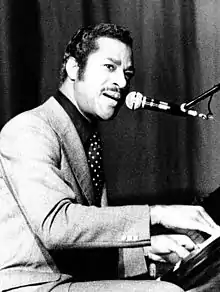Willie Mabon
Willie James Mabon (October 24, 1925 – April 19, 1985)[1][2] was an American R&B singer, songwriter and pianist, who had two number one hits on the Billboard R&B chart: "I Don't Know" in 1952 and "I'm Mad" in 1953.
Willie Mabon | |
|---|---|
 Mabon in 1976 | |
| Background information | |
| Birth name | Willie James Mabon |
| Born | October 24, 1925 Hollywood, Tennessee, U.S. |
| Died | April 19, 1985 (aged 59) Paris, France |
| Genres | Rhythm and blues |
| Occupation(s) | Singer, songwriter |
| Instruments | Piano, harmonica |
| Years active | 1949–1984 |
| Labels | |
Career
Mabon was born and brought up in the Hollywood district of Memphis, Tennessee. He moved to Chicago in 1942, by which time he had become known as a singer and pianist. He formed a group, the Blues Rockers, and in 1949 began recording for Aristocrat Records and then Chess Records.
His biggest success came in 1952 when his debut solo release, "I Don't Know", written by Cripple Clarence Lofton (who received no royalties),[3] topped the Billboard R&B chart for eight weeks.[4] It was one of the most popular releases of its era and was Chess's biggest hit before the successes of Chuck Berry and Bo Diddley. It was also one of the first R&B hit records to be covered by a leading white artist, Tennessee Ernie Ford. Mabon's original was played on Alan Freed's early radio shows and also sold well to white audiences, crossing over markets at the start of the rock-and-roll era.
Mabon returned to the top R&B slot in 1953 with "I'm Mad" and had another hit in 1954 with the Mel London song "Poison Ivy". However, his career failed to maintain its momentum, and record releases in the late 1950s on various labels were largely unsuccessful. Releases in the 1960s included "I'm the Fixer" and "Got to Have Some".[4]
He moved to Paris in 1972 and toured and recorded in Europe as part of the promoter Jim Simpson's "American Blues Legends" tour, recording The Comeback for Simpson's Big Bear Records and an album for Ornament Records in 1977.[5] He also performed at the Montreux Jazz Festival.[2] He died in April 1985, after a long illness, in Paris.
On June 25, 2019, The New York Times Magazine listed Willie Mabon among hundreds of artists whose material was reportedly destroyed in the 2008 Universal fire.[6]
See also
References
- Eagle, Bob; LeBlanc, Eric S. (2013). Blues: A Regional Experience. Santa Barbara, California: Praeger. p. 244. ISBN 978-0313344237.
- "Willie Mabon Biography". Oldies.com. Retrieved 19 January 2015.
- Russell, Tony (2006). The Penguin Guide to Blues Recordings. London: Penguin Books. p. 407. ISBN 0140513841.
- Russell, Tony (1997). The Blues: From Robert Johnson to Robert Cray. Dubai: Carlton Books. p. 139. ISBN 1-85868-255-X.
- Simpson, Jim (2019). Don't Worry 'Bout The Bear. Brewin Books. pp. 102–103. ISBN 978-1-85858-700-4.
- Rosen, Jody (June 25, 2019). "Here Are Hundreds More Artists Whose Tapes Were Destroyed in the UMG Fire". The New York Times. Retrieved June 28, 2019.